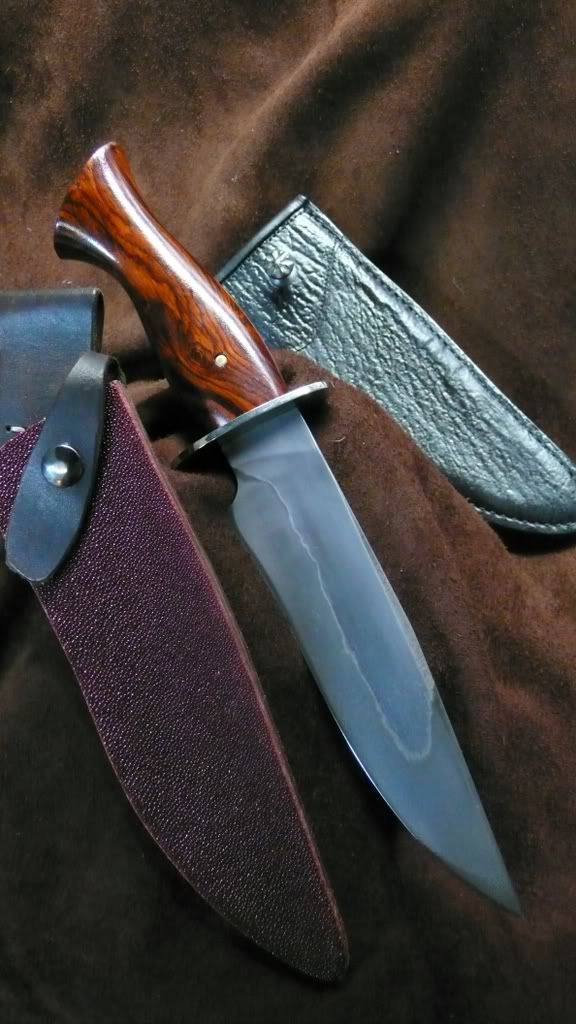I'm a huge hamon fan and have too many examples to post but I give credit to Mr. Branson for some of the finest I have seen.

Great thread and one I look forward to....

Hey Joe, not sure about CAS knives, but it isn't just a lamination line in Burt Foster's knives, there is also carbon migration which when treated optimally(a hand rubbed satin finish) will reveal itself much like a hamon.

Bill Burke fighter, I don't own it, but did handle it at Josh Smith's microshow a few years back. Stunning piece, good one to start off this thread as Billl studied with Ed Fowler, and now often stylistically differs from Ed, while using many of the techniques he did learn. P7's photo shows how difficult it can be to photograph a hamon effectively, while attractively displaying the rest of the knife.

Don Fogg American Bowie II-Not mine, never handled it. Kind of knife I dream about. Thing to worry about with a knife like this....the surface finish is extremely fragile(it is hand rubbed far in excess of 2000 grit) and keeping the hamon popping will present a challenge over the course of regular maintenance.

I do own this subhilt fighter by Burt Foster, and love it. You can clearly see the carbon migration in this photo. Steel can do some funny things, and what Burt had come up with for the way his steel gets laminated was just a little bit of genius and alchemy. In my opinion, at this point, no one does it better.

Matt Roberts fighter. Matt produced a very nice hamon, and imo was only going to get better. This example is the closest that I have presented of what I call the "American Hamon". It tends to be much wider than the other examples show, with a very pronounced turnback and very little figure to it.

Here is a J.D. Smith Shiv, a very rare and uniquely styled piece. J.D. crafted this one out of tamehagane that he had made himself.
This list has been liberated from ricecracker.com, and explains some of the different basic hamon in Japanese terminology:
Suguha (straight ) - Used from the beginning of Japanese sword manufacture to present day. Used by all five main schools (Gokaden) with different variations.
Midare - Heian period to present day. Ko-midare, choji midare, notare midare, gunome midare, O midare, hako midare, sudare midare, doran gunome midare, yahazu midare, mimigata midare amd hitatsura midare.
Choji (Clove Pattern) - Used from the late Heian period to present day. Many types were used and developed. Juka choji, kawazuku choji, saka choji are just some of the variations that were developed.
Gunome - Used from the Kamakura period, but different variations were developed from the original design during the Shinto period, especially the hamon known as gunome doran used by the Sukehiro School. Kanemoto made the sanbon sugi (3 cedar zig-zag) gunome hamon famous for its cutting ability during the Muromachi period.
Notare (Billowing wave) - Used from the late Kamakura period to present day, but ko-notare was seen in earlier periods as part of some hamons. The Soshu School was well known for using this within their hamons.
Hitatsura (Full) - Used from the late Kamakura period by the Soshu School, but became popular during the Muromachi period by most of the other main schools. Rarely seen in the late Shinto and Shinshinto period, even fewer during the gendaito periods.
Sudare/Kikusui ba (Bamboo strip/ Chysanthemum in the river) - Developed in the Shinto period, and a small group kept this hamon style alive during the Shinshinto period. Kyoto or Osaka Schools.
Fujiyama (Mount Fuji) - Developed from a notare midare with gunome within the hamon. Modified later in the Shinto period (1600’s) to resemble Mount Fuji. Popular also during the ShinShinto period, but rarely seen during the 1900’s.
Best Regards,
STeven Garsson













































